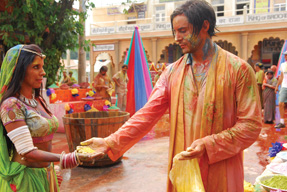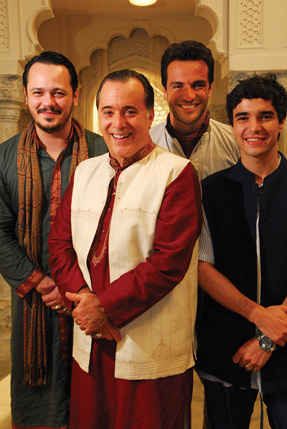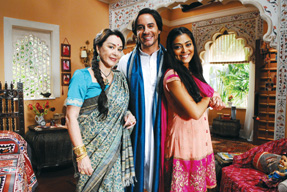Arts
Caminho Das Indians

A soap opera has Brazilians abuzz about India.
|
I am standing in the middle of what appears to be the old market in Jaipur. The shops are selling the usual fare — baskets, shawls, and peacock feather fans — and the sari merchants are leaning over their counters as the pankhas whir overhead. Traffic is bustling and a sari-clad woman rides by in a cycle rickshaw as men in kurta pyjamas dodge the auto rickshaws to stop at the chai-wallah on the corner. But something is not quite right. The auto rickshaws are oddly silent and have none of the usual black smoke chugging out the back. In fact, the whole street scene is eerily quiet to be anywhere in India. The street is also much too clean, missing the usual heady smell of incense, spices, mixed with the aroma of cows and other animals. Then a loud bell rings to signal the end of filming. I’m actually thousands of miles away in Rio de Janeiro, Brazil, on the set of Caminho das Indias.
Caminho das Indias, which means Road to India, is a telenovela, or evening soap opera, produced by Brazil’s Globo Television, and relates the story of two Indian families, all played by Brazilian actors speaking Portuguese. At the heart of the drama, a Romeo and Juliet tale of forbidden love between Maya Meetha, an upper caste girl who is set to marry, but is in love with Bahuan, an untouchable who made his fortune as a businessman in America. Over the eight months — one hour daily, six days a week — that it was on the air, it enjoyed record breaking audiences of up to 40 million people and generated a buzz in Brazil for all things Indian. Restaurants are offering Indian menus and designer shops are reporting record sales of everything from Indian jewellery to home furnishings. Travel agents are peddling tours of India for Brazilians, visiting locations featured in the show, and Indian inspired advertising can be seen on buses and billboards, selling everything from manicures to dental floss. Even in the remotest parts of Brazil, you will hear people uttering the smattering of Hindi used in the programme — are babre is now a common Brazilian expression!
The phenomenon the show inspired represents a new cultural flow between two countries identified as emerging economic superpowers. Even the Indian Consulate in Sao Paulo hosted an event to pay tribute to the role of Caminho das Indias in promoting Indian culture in Brazil. The show is the brainchild of screenwriter Gloria Perez, a veteran of the Brazilian soap opera genre, with many hit shows to her name. Her calling card is to offer up an exotic locale — previous dramas have been set in America, complete with cowboys in Western gear, and Morocco. So just how did an all-Brazilian film crew manage to re-create the lives of Indians? Only some key exterior scenes were filmed on location in India last year; everything else was painstakingly recreated on Globo’s vast back lot in Jacarepagua, one hour outside Rio. Months of research were undertaken to recreate the lively street scenes. Taking reference from Jaipur, Jodhpur and Mumbai, the production team constructed a small city of over 6,000 square metres, with 42 individual shops complete with Hindi signs, as well as a Hindu temple. Eight auto rickshaws and 12 bicycle rickshaws were made to order in Brazil. The details are remarkable — and I must admit that some of the scenes I had seen on TV, which I assumed were filmed in India, were actually shot on Globo’s back lot. This attention to detail secured the series a nomination for an international Emmy Award.
One of the hallmarks of the show were the costumes, and for head stylist, Emilia Duncan it was a big professional challenge. “When we started out, you could not even buy a sari here in Brazil so we had to get everything from India,” she said. While Duncan had experience in period costume dramas, she had never worked on anything involving India before. The research started with Sao Paulo’s 3,000 member Indian community, which Duncan and her team visited and photographed Indian wardrobes. “I had to learn everything from scratch — what is the difference between a kurta and a kurti, the different types of palus on saris, the jewellery.” Over 400 saris, ranging from elaborate wedding ensembles to more simple saris worn by the poor characters on the show, were brought from India. For Duncan, the men’s wardrobe proved more of a challenge. “From our research, we learned that many modern Indian men simply don’t wear traditional Indian clothes, so we had to find a way to make them not look too western,” she explains. The result is that the all Brazilian cast is sometimes convincing in their Indian roles, although the elaborate saris and jewellery are far more glamorous than you would find the average woman in Delhi wearing every day. In Caminho das Indias, everyone is dressed for a wedding, even if they are just stepping out to the shops or a casual lunch.
“We found a balance between the everyday life of Indians and glitz of Bollywood,” says Juliana Paes, who plays Maya Meetha, the main character of the show. Paes can now tie her own saris and apply her own khol eyeliner like an Indian woman. “We want to showcase the color, the glamour of Indian style and culture.” Paes has now become a household name in Brazil as a result of her role on the show, and with her exotic eyes and color, she is one of the most Indian looking of the cast. In fact, speaking with her on the set, with her bright pink sari tied Rajasthani style over her head, her arms full of bangles, and her elaborate nose ring, you feel as if you are talking to an Indian Barbie doll. The spell is broken as she lights up a Marlboro Light and relates the preparation for her role in Portuguese. “It was the first time for me playing a character from a different culture, and we studied to get the mannerisms right. Indians use the tips of their fingers a lot in gestures,” she explains. “And of course there is the famous Indian nod,” she wiggles her head convincingly, “which means yes, no, maybe.”
As part of her preparation for the role, she underwent three months of intensive studies before even travelling to India. She learned both Kathak and Bollywood dance, yoga, and watched more than 20 Bollywood films to observe the mannerisms and postures of Indian women. Brazil has long held a fascination for India. One popular bloco de carnaval (carnival music group) based out of Salvador, Bahia, is called Filhos de Gandhi, Sons of Gandhi. The group plays traditional Brazilian music, but dresses in dhotis and turbans and pays tribute to Mahatma Gandhi’s ideas of peace and non-violence.
But Caminho das Indias is the first time that Indian cultural norms have been portrayed in depth to a national Brazilian audience. Certain Indian customs that are part of the storyline have provoked considerable curiosity from Brazilians. The victimization of the untouchable class surprises people here, even in this country, which has one of the widest disparities between rich and poor. “I think here in Brazil, we do have great poverty, like in India. But there exists a dream that even a poor person can become president, as we have with Pres. Lula daSilva, who was a shoeshine boy. There is a sense of upward mobility,” says Paes. “But in India it seems that even with money, the Dalit class can never truly move up. And I think it is interesting that the show has provoked these discussions in Brazilian society.” Shivani Mutha, 21, worked at the Brazilian Consulate in Mumbai, and advised on various aspects of the production. She thinks it’s important to remember that the storylines may have a basis in truth, but are played for dramatic effect. After all, it is a soap opera. “I try to explain to Brazilians that there are laws and legislation to prevent discrimination against Dalits, so the show is not necessarily presenting the reality. But when it comes to the idea of arranged marriage, I do explain that me and my friends will marry someone who meets our family’s approval, yes.” Despite the show’s immense popularity, most Brazilian telenovelas never run longer than eight months, so Caminho das Indias came to an end on Sept. 11. During the last episode a staggering 8 out of every 10 television sets in Brazil tuned in to watch the conclusion. Globo Television has no plans to capitalize on the Indian buzz and says no new Indian-themed projects are in the pipeline.
But there is no doubt Brazilians fascination with India will live on. “There is something about the color and joy of Indian life that is linked to the Brazilian spirit and outlook. I do believe that the souls of our two countries are linked,” says chief stylist Duncan. |







